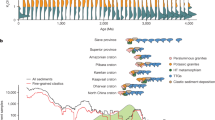Abstract
Ohmoto et al. reply - The idea of a methane-rich Archaean atmosphere has become popular since Rye et al. assumed in their calculation1 that siderite was absent in pre-2.2-Gyr palaeosols. We have concluded that the absence of siderite in some Archaean palaeosols does not constrain the atmospheric pCO2, but the presence of much siderite in sedimentary rocks does2. Sleep's recognition3 that siderite occurs in Archaean palaeosols substantiates our arguments2: although siderite should be absent in well aerated soils of all geological ages, it may form in waterlogged soils where pO2 became less than about 10−60 atm owing to the abundant anaerobic production of H2. In fact, we have reported this in a 2.6-Gyr soil profile at Schagen, South Africa4: abundant ferric-rich minerals formed while the soil was exposed to air, but ferrous-rich carbonate formed while it was apparently submerged under an anoxic pond.
This is a preview of subscription content, access via your institution
Access options
Subscribe to this journal
Receive 51 print issues and online access
$199.00 per year
only $3.90 per issue
Buy this article
- Purchase on Springer Link
- Instant access to full article PDF
Prices may be subject to local taxes which are calculated during checkout
Similar content being viewed by others
References
Rye, R., Kuo, P. H. & Holland, H. D. Nature 378, 603–605 (1995).
Ohmoto, H., Watanabe, Y. & Kumazawa, K. Nature 429, 395–399 (2004).
Sleep, N. Nature doi:10.1038/nature03167 (2004).
Watanabe, Y., Stewart, B. W. & Ohmoto, H. Geochim. Cosmochim. Acta 68, 2129–2151 (2004).
Brocks, J. J., Buick, R., Logan, G. A. & Summons, R. E. Geochim. Cosmochim. Acta 22, 4321–4335 (2003).
Rosing, M. T. & Frei, R. Earth Planet. Sci. Lett. 217, 237–244 (2004).
Jahnke, L. & Klein, H. P. J. Bacteriol. 155, 488–492 (1983).
Nisbet, E. G. in Early Precambrian Processes (eds Coward, M. P. & Ries, A. C.) 27–51 (The Geological Society, London, 1995).
Gottschalk, G. in Bacterial Metabolism 2nd edn 359 (Springer, New York, 1986).
Condie, K. C., Des Marais, D. J. & Abbott, D. Precambrian Res. 106, 239–260 (2001).
Kasting, J. F. Nature doi:10.1038/nature03166 (2004).
Kasting, J. F. Precambrian Res. 34, 205–229 (1987).
Kasting, J. F. in The Proterozoic Biosphere: A Multidisciplinary Study (eds Schopf, J. W. & Klein, C.) 1185–1187 (Cambridge Univ. Press, 1992).
Pavlov, A. A., Kasting, J. F., Eigenbrode, J. L. & Freeman, K. H. Geology 29, 1003–1006 (2001).
Pavlov, A. A. & Kasting, J. F. Astrobiology 2, 27–41 (2002).
Author information
Authors and Affiliations
Corresponding author
Rights and permissions
About this article
Cite this article
Ohmoto, H., Watanabe, Y. Archaean palaeosols and Archaean air (reply). Nature 432, 1–2 (2004). https://doi.org/10.1038/nature03168
Published:
Issue Date:
DOI: https://doi.org/10.1038/nature03168
Comments
By submitting a comment you agree to abide by our Terms and Community Guidelines. If you find something abusive or that does not comply with our terms or guidelines please flag it as inappropriate.



